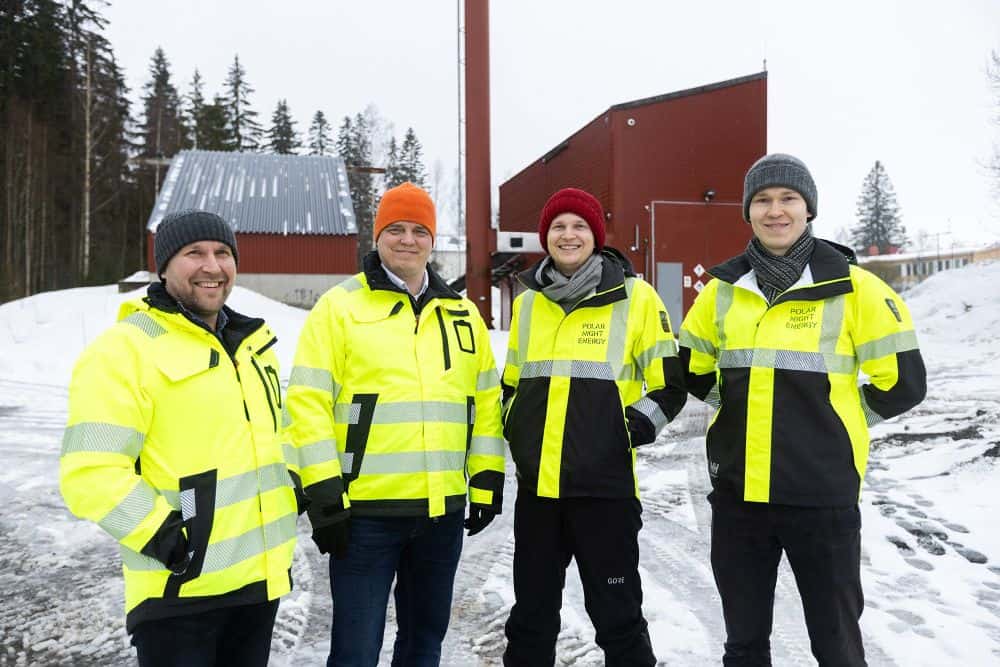
[Image above] Loviisan Lämpö’s CEO Mikko Paajanen and CapMan Infra’s investment director Sauli Antila with Polar Night Energy’s product sales manager Matti Ulvinen and CEO Tommi Eronen (from left to right) at Pornainen district heating plant. The new Polar Night Energy sand battery system will be built next to the old district heating plant. Credit: Marjaana Malkamäki, Polar Night Energy
When energy security first became a topic of discussion in the 1970s and 1980s, the focus was on securing a stable supply of cheap oil under threats of embargoes and price manipulations by exporters. But in today’s world, energy security dialogue is now closely entangled with other energy policy problems, such as providing equitable access to modern energy and mitigating climate change.
Variations in energy security priorities and policies do not necessarily mean that people have different concepts of energy security, researchers from Sweden and Austria explain in an open-access paper.
“It may instead mean that one and the same concept finds different expressions under different conditions,” they write.
For example, if energy security is understood to encompass the “four As” introduced by the Asia Pacific Energy Research Center—availability, accessibility, affordability, and acceptability—the relative importance of each aspect will vary depending on where you live. People in sub-Saharan Africa may struggle to access electricity, while people in the United States may struggle to afford electricity.
In Finland, availability of renewable energy sources is a major challenge. While people living in Finland experience an overabundance of sunlight during the summer—most parts of the country go months without experiencing a sunset—in winter time, no sunlight is seen in the region. Thus, finding ways to store solar energy when it is available is a focus for Finnish energy policies.
Finnish startup Polar Night Energy believes it can address this challenge through its novel “sand battery” system.
In this system, electricity generated from solar and wind power is passed through an array of electric resistive heating elements, heating the air around it. This hot air is circulated through a network of pipes inside an insulated sand-filled steel tank, which warms the sand up to about 500°C (932°F). The air then flows back out of the tank into a heat exchanger, where it heats water that is then circulated through building heating systems.
Tommi Eronen and Markku Ylönen, the engineers who created Polar Night Energy, chose to use sand as the heat storage medium due to its superior heat storage capacity compared to existing water-based heat storage systems.
“There is only so much heat you can add to water before it becomes steam. Steam can efficiently distribute heat, but it is not really cost-effective for large-scale storage,” Eronen said during an interview in 2022.
In July 2022, CTT reported on the first commercial installation of Polar Night Energy’s sand battery system in the town of Kankaanpää. Now, in March 2024, Polar Night Energy announced it has entered into an agreement with Finnish district heating company Loviisan Lämpö to build an industrial-scale sand battery system in Pornainen for Loviisan Lämpö’s district heating network.
The new sand battery system will be about 10 times larger than the one in operation in Kankaanpää, with a thermal energy storage capacity of 100 MWh. This capacity equates to almost one month’s heat demand in summer and a one-week demand in winter.
Unlike the system in Kankaanpää, the sand battery in Pornainen will use crushed soapstone as the thermal storage medium. This material is a byproduct from the manufacture of heat-retaining fireplaces by Tulikivi, Finland’s largest stone processor and the world’s largest manufacturer of heat-retaining masonry heaters.
In a press release, Tulikivi CEO Heikki Vauhkonen says, “Collaborating with Polar Night Energy is an interesting venture into new business, leveraging the traditional strengths of soapstone, such as excellent heat conduction and retention properties. This collaboration supports Tulikivi’s goals of maximizing the utilization of raw materials.”
Construction and testing of the 13 meters high by 15 meters wide battery is estimated to take around 13 months, meaning it should be ready to keep residents warm by 2025.
“It’s exciting to build a large-scale thermal energy storage, which will also act as a primary production plant in Pornainen’s district heating network. This is a significant step in scaling up the sand battery technology,” says Liisa Naskali, chief operating officer at Polar Night Energy, in the press release.
